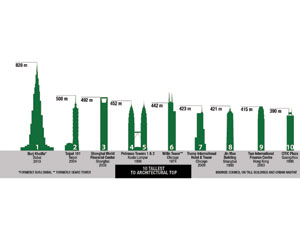There is at least one superlative associated with the world’s tallest structure that few know about: The 828-meter Burj Dubai, renamed Burj Khalifa on its opening day, Jan. 4, is likely the most monitored skyscraper in the world, from its foundation to the top of its pinnacle. Data collected from the building’s permanent sensors will be used to refine design and construction methods for future supertall towers, say sources.
The burj’s lead contractor, Samsung C&T Corp., already used data collected during construction to validate design assumptions. “I was able to actually recalibrate the structural analysis model to reflect what we measured,” says Ahmad Abdelrazaq, executive vice president of Samsung, Seoul, and a former structural engineer in the Chicago office of the burj’s architect-engineer, Skidmore, Owings & Merrill. “Through the model, I was able to predict lateral drift, including long-term effects, precisely and accurately,” he adds.
SOM has been monitoring some of its tall buildings for years. “The data helps us to further refine our working assumptions related to tall-building design and behavior,” says William F. Baker, SOM’s structural partner.
For the burj, SOM specified a limited monitoring system to capture structural behavior and measure wind. Samsung greatly enhanced the program. “The potential benefit from the instrumentation could be great,” says Baker.
The monitoring program is the culmination of a testing program for concrete elements that began at the start of construction (ENR 11/6/06 p. 28). During work, instruments monitored foundation settlement, column shortening and the tower’s dynamics and behavior. The contractor also used optical surveys and a global positioning system, especially at the top, where the spire and pinnacle are “lively” due to wind, to help position the tower. Thanks to the sensors and the “robust” survey system, Samsung was able to build the tower with a very high degree of accuracy, better than what is typical for all-steel construction, says Abdelrazaq.
The program goes beyond construction. There is permanent instrumentation, including strain gauges, to continue monitoring dynamic behavior of the tower under lateral loads and the structural behavior of the steel pinnacle.
Abdelrazaq hopes to share his findings. “We must have the will and time to pursue [answers to questions] about tall-building design, and we must feed them back to designers of supertall buildings and to future generations,” he says.
The Council on Tall Buildings and Urban Habitat, keeper of building height records, has yet to verify the burj’s height. But assuming the numbers released on Jan. 4 by developer Emaar Properties are accurate, the burj is the tallest building in the world based on height to architectural top, height to highest occupied floor and height to tip. Under the first category, the burj is 320 m taller than the second-tallest building, the 509-m Taipei 101.
The six-million-sq-ft, multi-use tower, completed more than a year late, is barely occupied. The 124th-floor observation deck started receiving visitors on Jan. 5, but the tower, designed to accommodate 12,000 condominium, hotel and office occupants, is not likely to have any residents until next month.




Post a comment to this article
Report Abusive Comment